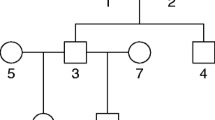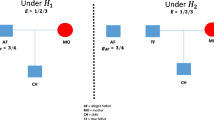Abstract
This paper considers the statistical evaluation of DNA mixtures in the following situations: (1) two unknown contributors are related respectively to two typed persons, (2) two of the unknown or untyped contributors are related and the third unknown contributor is related to a typed person, or (3) there are two pairs of related unknown contributors to the DNA mixture. The corresponding formulas for evaluating the likelihood ratios on the strength of DNA evidence are derived and the kinship coefficients for the related persons are incorporated into the calculations. Two examples are analyzed for illustration.
Similar content being viewed by others
References
Balding DJ, Donnelly P, Nichols RA (1994) Comment: some causes for concern about DNA profiles. Stat Sci 9:248–251
Brookfield FFY (1994) The effect of relatives on the likelihood ratio associated with DNA profile evidence in criminal cases. J Forensic Sci Soc 34:193–197
Donnelly P (1995) Nonindependence of matches at different loci in DNA profiles: quantifying the effect of close relatives on the match probability. Heredity 75:26–34
Evett IW (1992) Evaluating DNA profiles in case where the defense is “It is my brother”. J Forensic Sci Soc 32:5–14
Fukshansky N, Bär W (1998) Interpreting forensic DNA evidence on the basis of hypotheses testing. Int J Legal Med 111:62–66
Fukshansky N, Bär W (2000) Biostatistics for mixed stain: the case of tested relatives of a non-tested suspect. Int J Legal Med 114:78–82
Fung WK, Hu YQ (2001) The evaluation of mixed stains from different ethnic origins: general result and common cases. Int J Legal Med 115:48–53
Fung WK, Hu YQ (2004). Interpreting DNA mixtures with related contributors in subdivided populations. Scand J Stat 31:115–130
Hu YQ, Fung WK (2003) Interpreting DNA mixtures with the presence of relatives. Int J Legal Med 117:39–45
Roeder K (1994) DNA fingerprinting: a review of the controversy. Stat Sci 9:222–247
Sjerps M, Kloosterman AD (1999) On the consequences of DNA profile mismatches for close relatives of an excluded suspect. Int J Legal Med 112:176–180
Stockmarr A (2000) The choice of hypotheses in the evaluation of DNA profile evidence. In: Gastwirth JL (ed) Statistical science in the courtroom. Springer, New York, pp 143–160
Weir BS, Triggs CM, Starling L, Stowell LI, Walsh KAJ, Buckleton J (1997) Interpreting DNA mixtures. J Forensic Sci 42:213–222
Acknowledgements
We thank the referees for helpful comments that improved the presentation of the paper. This work was partially supported by the Hong Kong RGC Competitive Earmarked Research Grant HKU 7022/04P, and the National Natural Science Foundation of China (10329102).
Author information
Authors and Affiliations
Corresponding author
Appendix
Appendix
Lemma 1
If the kinship coefficients of two individuals X1 and X2 are (k0,2k1,k2), then for any set of alleles D
where χ1 and χ2 are the genetic profiles of X1 and X2 respectively.
Proof
They are just Eqs. 4 and 5 in Hu and Fung (2003).
Lemma 2
For any U⊂M, and any pairwise distinct alleles a,b,c,d,∈U,
Proof
It is sufficient to note that \(I_{D} (a) = 1 \Leftrightarrow a \in D \Leftrightarrow (M \setminus U) \cup \{ a\} \subset D \subset M \Leftrightarrow M \setminus (U \setminus \{ a\} ) \subset D \subset M\), so
Thus Eq. 12 follows immediately from Eq. 3.
Similarly, \(I_{D} (a)I_{D} (b) = 1 \Leftrightarrow a,b \in D \Leftrightarrow (M \setminus U) \cup \{ a,b\} \subset D \subset M \Leftrightarrow M \setminus (U \setminus \{ a,b\} ) \subset D \subset M\). So Eq. 13 holds by Eq. 3.\(I_{D} (a)I_{D} (b)I_{D} (c) = 1 \Leftrightarrow a,b,c \in D \Leftrightarrow (M \setminus U) \cup \{ a,b,c\} \subset D \subset M \Leftrightarrow M \setminus (U \setminus \{ a,b,c\} ) \subset D \subset M\), so Eq. 14 holds by Eq. 3.\(I_{D} (a)I_{D} (b)I_{D} (c)I_{D} (d) = 1 \Leftrightarrow a,b,c,d \in D \Leftrightarrow (M \setminus U) \cup \{ a,b,c,d\} \subset D \subset M \Leftrightarrow M \setminus (U \setminus \{ a,b,c,d\} ) \subset D \subset M\), so Eq. 15 holds by Eq. 3.
Lemma 3
For any U⊂M, and any alleles a,b,c,d, we have
Proof
If a∉M, then both sides of Eq. 16 are zero; if a∈M∖U, then Eq. 16 is just Eq. 3; if a∈U, then Eq. 16 is just Eq. 12. Thus, Eq. 16 holds.
If a=b, then Eq. 17 is just Eq. 16. Next, we consider a≠b. If a or b is not in M, then both sides of Eq. 17 are zero; if a,b, ∈U, then Eq. 17 is just Eq. 13; if a∈U and b∈M∖U, then Eq. 17 is just Eq. 16; if a,b∈M∖U, then Eq. 17 is just Eq. 3. Thus, we have Eq. 17 by the symmetry of a and b.
If two of a,b,c, are identical, then Eq. 18 is just Eq. 17. So we consider that a,b and c are pairwise distinct. If one of a,b, and c is not in M, then both sides of Eq. 18 are zero; if a,b,c∈U, then Eq. 18 is just Eq. 14; if a,b,∈U and c∈M∖U, then Eq. 18 is just Eq. 17; if a ∈U and b,c∈M∖U, then Eq. 18 is just Eq. 16; if a,b,c ∈M∖U, then Eq. 18 is just Eq. 3. By the symmetry of a,b and c, Eq. 18 is hence proved.
If two of a,b,c and d are identical, then Eq. 19 is just Eq. 18. So we assume a,b,c and d are pairwise distinct. If one of a,b,c and d is not in M, then both sides of Eq. 19 are zero; if a,b,c,d∈U, then Eq. 19 is just Eq. 15; if a,b,c,∈U and d∈M∖U, then Eq. 19 is just Eq. 18; if a,b,∈U and c,d∈M∖U, then Eq. 19 is just Eq. 17; if a∈U and b,c,d∈M∖U, then Eq. 19 is just Eq. 16; if a,b,c,d∈M∖U, then Eq. 19 is just Eq. 3. Thus we prove Eq. 19 by the symmetry of a, b, c and d.
Proof of Eq. 5
Under the hypothesis declared in Eq. 4, the only related individuals are X1 and T1, and X2 and T2. Let χ1, χ2, and χ0 be the genetic profiles of X1, X2, and the other x−2 unknown contributors, respectively, then we have χ=χ1⋃χ2⋃χ0 and further by Eq. 2
Using Eq. 11 for the first two items in Eq. 20, \(P({\mathop \chi \nolimits_0 } \subset D) = ({\sum\nolimits_{i \in D} }\,p_{i} )^{{2(x - 2)}}\), and the results of Lemma 3, we can have Eq. 5 from Eq. 1 after some matrix manipulation.
Proof of Eq. 7
Under hypothesis declared in Eq. 6, the only related individuals are X1 and T1, and X2 and X3. Let χ1, χ2, χ3, and χ0 be the genetic profiles of X1, X2, X3, and the other x−3 unknown contributors, respectively, then we have χ=χ1⋃χ2⋃χ3⋃χ0 and further by Eq. 2
Substituting Eqs. 10, 11, and \(P({\mathop \chi \nolimits_0 } \subset D) = ({\sum\nolimits_{i \in D} }\,p_{i} )^{{2(x - 3)}}\) into the expression of W(D) in Eq. 21 and then using Lemma 3, we can have Eq. 7 from Eq. 1 after some matrix manipulation.
Proof of Eq. 9
Under the hypothesis declared in Eq. 8, the only related individuals are X1 and X2, and X3 and X4. Let χ1, χ2, χ3, χ4, and χ0 be the genetic profiles of X1, X2, X3, X4, and the other x−4 unknown contributors, respectively, then we have χ=χ1⋃χ2⋃χ3⋃χ4⋃χ0 and further by Eq. 2
Substituting Eq. 10 and \(P({\mathop \chi \nolimits_0 } \subset D) = ({\sum\nolimits_{i \in D} }\,p_{i} )^{{2(x - 4)}}\) into Eq. 22 and then using Lemma 3, we have Eq. 9 from Eq. 1 after some matrix manipulation.
Rights and permissions
About this article
Cite this article
Hu, YQ., Fung, W.K. Evaluation of DNA mixtures involving two pairs of relatives. Int J Legal Med 119, 251–259 (2005). https://doi.org/10.1007/s00414-004-0493-9
Received:
Accepted:
Published:
Issue Date:
DOI: https://doi.org/10.1007/s00414-004-0493-9




